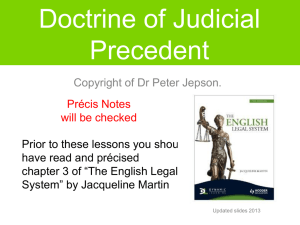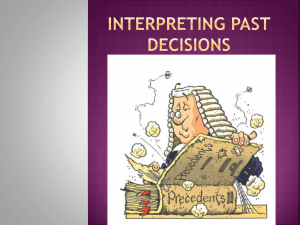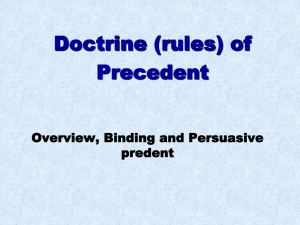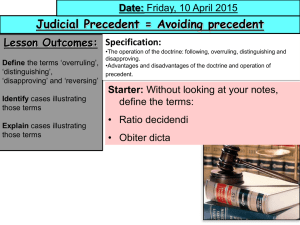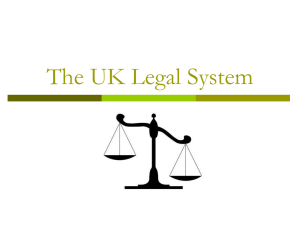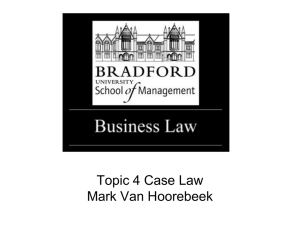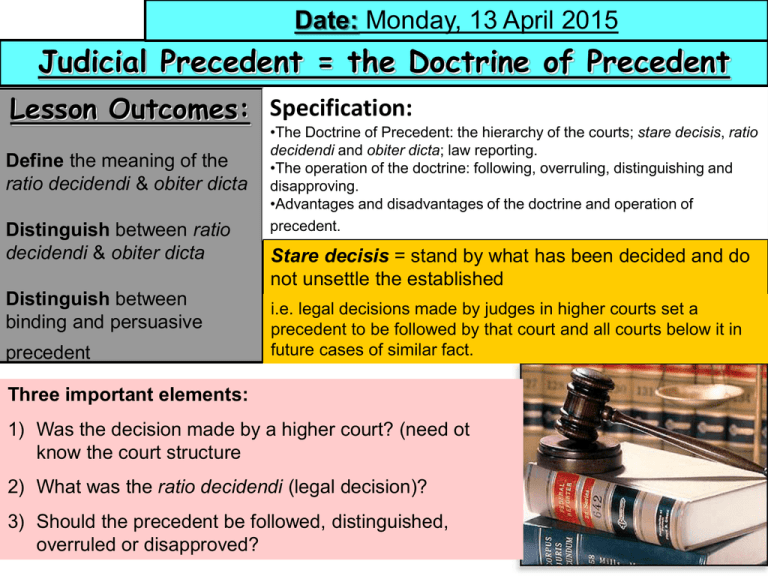
Date: Monday, 13 April 2015
Judicial Precedent = the Doctrine of Precedent
Lesson Outcomes: Specification:
Define the meaning of the
ratio decidendi & obiter dicta
Distinguish between ratio
decidendi & obiter dicta
Distinguish between
binding and persuasive
precedent
•The Doctrine of Precedent: the hierarchy of the courts; stare decisis, ratio
decidendi and obiter dicta; law reporting.
•The operation of the doctrine: following, overruling, distinguishing and
disapproving.
•Advantages and disadvantages of the doctrine and operation of
precedent.
Stare decisis = stand by what has been decided and do
not unsettle the established
i.e. legal decisions made by judges in higher courts set a
precedent to be followed by that court and all courts below it in
future cases of similar fact.
Three important elements:
1) Was the decision made by a higher court? (need ot
know the court structure
2) What was the ratio decidendi (legal decision)?
3) Should the precedent be followed, distinguished,
overruled or disapproved?
1
Ratio decidendi
Obiter Dicta
= ‘the reason for deciding’ i.e. the legal
decision/principle of a case
= ‘other things said’
•
•
•
•
This is binding precedent and must be
applied (followed) in all other cases in
lower courts that have the same facts or
are looking at the same point of law
This is the only part of the legal decision
that is binding on other cases
Sir Rupert Cross defined this as “any rule
expressly or impliedly treated by the
judge as a necessary step in reaching
his conclusion”
•
•
•
Hypothetical situations considered by
a judge that are not part of the
decision
E.g. in Hill v Baxter the judge talked
about what would have happened if a
swarm of bees had flown into a car
while someone was driving (even
though this had nothing to do with the
case!)
This hypothetical discussion is not
binding precedent.
However, this could be considered
persuasive precedent e.g. if there is
a case in the future where a swarm of
bees flies into a car, they may follow
the hypothetical obiter dicta of Hill v
Baxter!
R v Howe & Bannister [1987] 2 WLR 568 House of Lords
Howe & Bailey both aged 19 and Bannister aged 20, were acting under orders of Murray aged 35. The
charges related to two murders and one conspiracy to murder. The first murder related to a 17 year old
male victim, Elgar. Murray had driven them all to a public lavatory. Elgar was naked and sobbing and was
subjected to torture and compelled to undergo sexual perversions. Howe and Bannister took part in
kicking and punching Elgar and were told they would succumb to similar treatment if they did not do as
Murray ordered. Bailey strangled Elgar resulting in his death. The second killing took place the following
night at the same location on a 19 year old male Pollitt. Murray had ordered Howe and Bannister to
strangle him and they complied. The third charge related to a similar incident, however, the intended
victim managed to escape.
Ratio Decidendi – The defence of duress is not available for murder whether it be a principal in the
first or second degree. DPP for Northern Ireland v Lynch overruled.
Obiter dicta - The defence should not be available to one who attempts murder. (It was an obiter
statement as the offence was one of murder not attempted murder)
3
R v Brown [1993] 2 All ER 75 House of Lords
The five appellants were convicted on various counts of ABH and wounding a under the Offences
Against the Person Act 1861. The injuries were inflicted during consensual homosexual sadomasochist
activities. The trial judge ruled that the consent of the victim conferred no defence and the appellants
thus pleaded guilty and appealed. The Court of Appeal upheld the convictions and certified the following
point of law of general public importance: "Where A wounds or assaults B occasioning him actual bodily
harm in the course of a sado-masochistic encounter, does the prosecution have to prove lack of consent
on the part of B before they can establish A's guilt under section 20 and section 47 of the 1861, Offences
Against the Person Act?"
Ratio Decidendi – The defence of consent cannot be relied on in offences under s.47 and s.20 OAPA
1861 where the injuries resulted from sadomasochist activities.
Obiter dicta - The defence could be allowed in other circumstances such as ritual circumcision,
tattooing, ear and body piercing and violent sports
4
Defining key terms
Stare Decisis
Ratio decidendi
Obiter Dicta
Binding and persuasive precedent
Binding precedent is one that must be followed
• Ratio decidendi is a binding precedent
• Binding on all courts of same level and below
Persuasive precedent is one that may be followed
• Obiter dicta is a persuasive precedent
• There are other forms of persuasive precedent:
– Decisions in courts of other countries
– Decisions of the Judicial Committee of the Privy Council
– Dissenting judgments
Task: Using the information in 5.1.6 (p.63-64), summarise the
situation in which persuasive precedent has been followed.
Don’t forget to include authority.
6
Decisions of courts of other
countries
• Scottish, US & especially Commonwealth
countries are persuasive
• Because they have legal systems based on
UK system
• This is due to previous or continuing
dependence
• Examples include R v R (1991) which
followed a decision in the Scottish Courts and
Lister v Helsley Hall (2001) which followed a
Canadian Court ruling
7
R v R [1991] 3 WLR 767 House of Lords
The defendant was charged with the attempted rape of his wife. At the time of the offence the couple had
separated although no formal legal separation existed and neither party had partitioned for a divorce.
Ratio Decidendi – The House of Lords overturned the matrimonial exception to rape. His conviction
for rape was upheld.
8
Lister v Helsley Hall [2001] 2 All ER 769
A number of former pupils sued in respect of sexual abuse by the warden of a residential school.
Ratio Decidendi – Overruling T v North Yorkshire, (by using the obiter dicta decisions in two
Canadian Court rulings) the House of Lords said there had been a close connection between the
warden's acts and his employment at the school, and it would not be unfair or unjust to hold the
defendants vicariously liable. An employer is vicariously liable for the criminal acts of an employee if
those acts are so closely connected to what the employee was employed to do that it is fair and just to
hold the employer responsible.
9
Decisions of the Privy Council
• Final appeal court for Commonwealth
countries
• Highly persuasive
• Equivalent in rank to the Supreme Court
• Staffed by the same judges who sit in
Supreme Court
• Good examples are Attorney General for
Jersey v Holley (2005) against R v Smith
(Morgan) (2000)
10
R v Smith (Morgan) [2000] 3 WLR 654 House of Lords
The appellant, an alcoholic suffering from a depressive illness, stabbed his drinking partner after a row
over some stolen tools. The trial judge ruled that severe depressive illness was not a matter for the jury
to take into account in deciding whether an ordinary man sharing the respondent's characteristics would
have lost his self control. In his summing up he told the jury that a depressive state was a characteristic
to be taken into account when dealing with the gravity of the provocation but that the fact that the
depressive illness might have disinhibited the respondent from behaving violently was irrelevant. The jury
returned a verdict of murder and the appellant appealed contending the jury should have been allowed to
take into account his depressive illness in assessing his reaction to the provocation. The Court of Appeal
allowed the appeal holding that there had been a mis-direction. The Crown appealed to the House of
Lords.
Ratio Decidendi – The House of Lords preferred the dissenting opinion in Luc Thuet Thuan holding
that mental characteristics can be taken into account in assessing both the gravity of the provocation and
the reaction of the defendant in relation to a reasonable man. The appeal was therefore dismissed.
11
Attorney General for Jersey v Holley [2005] 3 WLR 29 Privy Council
A landmark case where the Privy Council declared that they were announcing the law applicable not only to
Jersey but also to England and Wales. (Privy Council decisions are not generally considered binding in English
law but of mere persuasive authority). The Judicial Committee consisted of nine members of the House of Lords.
The defendant had a stormy relationship with the deceased. They were both alcoholics and he had a history of
violence towards her for which he had spent time in prison. On his release from prison she indicated that she did
not want to continue the relationship. However, they continued to live together having constant rows. On the day
in question they had both been to the pub in the afternoon. He returned early because of an argument. She
returned in the evening and announced that she had had sex with another man. He hacked her to death with an
axe. At his trial he raised the defence of provocation. He wished to rely on his alcoholism, depression and other
personality traits. The jury convicted him of murder. The defendant appealed to the Court of Appeal who
quashed the conviction and ordered a retrial. He was again convicted at the retrial and again appealed. His
conviction was again quashed and a manslaughter conviction was substituted. The Attorney General sought
leave to appeal arguing the decision in Smith (Morgan) was wrong and should not apply in Jersey.
Ratio Decidendi – Held: 6:3 Decision (Lords Carswell, Bingham and Hoffman dissenting). The appeal was
allowed. The law in Jersey and England & Wales is the same on this issue. The decision in Smith (Morgan)
allowing mental characteristics to be attributed to the reasonable man in assessing the standard of self-control
expected of the defendant is no longer good law.
12
Dissenting judgments
• In appeal courts cases heard by more than
one judge
• Sometimes decision reached by only a
majority of judges
• Judges in minority will give reasons for
different decision
• This is called a dissenting judgment
• Example Candler v Crane Christmas (1951)
followed in Hedley Byrne v Heller and
Partners (1966)
13
Candler v Crane Christmas & Co [1951] 2 KB 164
An investor relied on the careless and wrong company’ financial statement which caused economic loss
and then failed to claimed the damage from a negligence claim.
Ratio Decidendi – The Court of Appeal held that although in this situation, the accountant knew that
the financial statement will be relied upon by third party, no duty of care was imposed in relation to
receiving careless advice by the accountants in preparing a company’s financial statement. This is
because, no contractual relationship existed between them. In this case, Denning LJ dissenting argued
that the defendant not only owed the duty of care to their employee or client but the defendant also owed
a duty of care to any third parties to whom they themselves show the financial statement. An accountant
must consider that someone will rely on the statement to invest money or take action with the statement.
14
Hedley Byrne & Co Ltd v Heller & Partners Ltd [1963] (HL)
PP were advertising agents who booked TV time on behalf of E Ltd. They asked their bankers to obtain a
reference from E's bankers, and the latter replied favourably. E went into liquidation; PP lost money and
sued E's bankers.
Ratio Decidendi – The arguments of Denning LJ in the cases Candler v Crane Christmas & Co were
followed when the House of Lord was prepared to extend the duty of care in the Hedley Byrne cases.
The House of Lords said the bankers owed PP a duty of care (however, they escaped liability because of
a disclaimer in their statement, denying legal responsibility for its accuracy.)
15
Date: Monday, 13 April 2015
Judicial Precedent – Hierarchy of the courts
Lesson Outcomes:
•Describe the hierarchy of the courts
•Explain which courts are bound by
other courts & the exceptions to this
Specification:
•The Doctrine of Precedent: the hierarchy
of the courts; stare decisis, ratio decidendi
and obiter dicta; law reporting.
General Rule:
1) Every court is bound to follow a decision from a court above
2) Appellate courts are bound by their own past decisions
Starter: What is the name of the
highest court in England & Wales?
http://www.youtube.com/watch?
v=wTHrynZIsBo&feature=player
_embedded
16
Civil Cases
Criminal Cases
European Court of Justice
European Court of Justice
Supreme Court (formerly House of
Lords)
Supreme Court (formerly House of
Lords)
Court of Appeal (Civil Division)
Court of Appeal (Criminal Division)
Divisional Courts
Queen’s Bench Divisional Court
High Court
Crown Court
County Court
Magistrates’ Court
Magistrates’ Court
Court
European
Court
Supreme
Court
Court of
Appeal
Divisional
Courts
High Court
Crown Court
Courts bound by it
Courts it is bound by
The Supreme Court
Until 1966 the House of Lords was
bound by its own previous
decisions unles they were made
per incuriam (through lack of care)
e.g. failing to refer to the relevant
Act or precedent
London Street Tramways v London County Council (1898) AC 375
Earl of Halsbury LC:
"a decision of this House once given upon a point of law is conclusive upon this House
afterwards, and that it is impossible to raise that question again as if it was res integra
and could be re-argued, and so the House be asked to reverse its own decision. That
is a principle which has been, I believe, without any real decision to the contrary,
established now for some centuries, and I am therefore of opinion that in this case it is
not competent for us to rehear and for counsel to re-argue a question which has been
recently decided."
The Supreme Court
In 1966 the Lord Chancellor issued a
Practice Statement stating that it would
be OK for the House of Lords to depart
from its own decisions but it should be
used sparingly in order to maintain
certainty and consistency.
British Railways Board v Herrington (1972) AC 877
A six year old boy was electrocuted and suffered severe burns when he wondered from a
play park onto a live railway line. The railway line was surrounded by a fence however, part
of the fence had been pushed down and the gap created had been used frequently as a
short cut to the park. The defendant was aware of the gap in the fence which had been
present for several months, but had failed to do anything about it.
Principle – Under existing authority of Addie v Dumbreck (1929) no duty of care was owed
to trespassers. However, the House of Lords departed from their previous decision using the
1966 Practice Statement and held that the defendant railway company did owe a duty of
common humanity to trespassers.
Independent reading
There is much more information regarding the Supreme Court,
House of Lords and the use of the Practice statement in your
textbook.
Make sure you read this independently, take notes and note down
the key authority (cases)
Key points & cases
• Use of the Practice Statement in Civil Law
• Herrington v British Railways Board
• Knuller v DPP- Lord Reid quote (S&C)
•Use of the Practice Statement in criminal law
•Shivpuri – Lord Bridge quote (S&C)
•R v G and R
• Whether the Practice Statement applies to the Supreme Court
•Austin v London Borough of Southwark
The Court of Appeal
• Directly below the Supreme Court & bound by
its decisions
• Two Divisions
– Civil Division
– Criminal Division
• Each Division usually is usually bound by its
own decisions (see exceptions below) but the
two divisions do not bind eachother
Young v Bristol Aeroplane Co Ltd [1944] KB 718 Court of Appeal
Lord Greene MR:
"The Court of Appeal is bound to follow its own decisions and those of courts of co-ordinate
jurisdiction, and the ' full ' court is in the same position in this respect as a division of the court
consisting of three members. The only exceptions to this rule are:—
(1) The court is entitled and bound to decide which of two conflicting decisions of its
own it will follow ;
(2) the court is bound to refuse to follow a decision on its own which, though not expressly
overruled, cannot, in its opinion, stand with a decision of the House of Lords ;
(3) the court is not bound to follow a decision of its own if it is satisfied that the decision was
given per incuriam, e.g., where a statute or a rule having statutory
effect which would have affected the decision was not brought to the attention of the earlier
court.”
Independent reading
There is much more information regarding the Court of Appeal
and when it can and cannot be bound by precedent.
Make sure you read this independently, take notes and note down
the key authority (cases)
Key points & cases
•Lord Denning’s attempts to say that the Court of Appeal doesn’t have to follow the
House of Lords (stretch & challenge)
•Young v Bristol Aeroplane – 3 rules as to when the Court of Appeal isn’t bound by its
own decisions
•Confirmed in Davis v Johnson
•Williams v Fawcett
• quote from Rickards v Rickards
• Read the red box comment (Stretch & Challenge)
• ‘Misapplied or misunderstood’ – Taylor, Gould, Spencer
The High Court
The Royal Courts of Justice building
houses the Court of Appeal and the
High Court
• Two roles
– Court of first instance (hears initial cases)
– Appeal court
• Three Divisions
– Family Division
– Chancery Division
– Queen’s Bench Division
• Each of these has its own Divisional Court
• Bound by decisions made in appeal cases in
the Divisional Courts of the High Court
• In criminal appeals heard in Divisional Court of
the Queen’s Bench Division the additional rule
about injustice and liberty also applies
• First instance decisions in High Court must be
followed by lower courts but need not be
followed by other High Court Judges
– However, these are highly persuasive and
generally followed
24
The Lower Courts
• The Crown Courts, County Courts, and
Magistrates Courts do not set binding
precedents
• Decision of Crown Courts are persuasive
• Normally decisions in these courts are not
reported in the law reports
25


